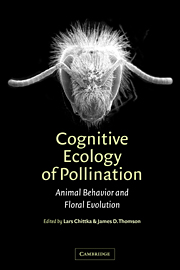Book contents
- Frontmatter
- Contents
- List of contributors
- Preface
- 1 The effect of variation among floral traits on the flower constancy of pollinators
- 2 Behavioral and neural mechanisms of learning and memory as determinants of flower constancy
- 3 Subjective evaluation and choice behavior by nectar-and pollen-collecting bees
- 4 Honeybee vision and floral displays:from detection to close-up recognition
- 5 Floral scent, olfaction, and scent-driven foraging behavior
- 6 Adaptation, constraint, and chance in the evolution of flower color and pollinator color vision
- 7 Foraging and spatial learning in hummingbirds
- 8 Bats as pollinators: foraging energetics and floral adaptations
- 9 Vision and learning in some neglected pollinators: beetles, flies, moths, and butterflies
- 10 Pollinator individuality: when does it matter?
- 11 Effects of predation risk on pollinators and plants
- 12 Pollinator preference, frequency dependence, and floral evolution
- 13 Pollinator-mediated assortative mating: causes and consequences
- 14 Behavioural responses of pollinators to variation in floral display size and their influences on the evolution of floral traits
- 15 The effects of floral design and display on pollinator economics and pollen dispersal
- 16 Pollinator behavior and plant speciation: looking beyond the “ethological isolation” paradigm
- Index
1 - The effect of variation among floral traits on the flower constancy of pollinators
Published online by Cambridge University Press: 13 August 2009
- Frontmatter
- Contents
- List of contributors
- Preface
- 1 The effect of variation among floral traits on the flower constancy of pollinators
- 2 Behavioral and neural mechanisms of learning and memory as determinants of flower constancy
- 3 Subjective evaluation and choice behavior by nectar-and pollen-collecting bees
- 4 Honeybee vision and floral displays:from detection to close-up recognition
- 5 Floral scent, olfaction, and scent-driven foraging behavior
- 6 Adaptation, constraint, and chance in the evolution of flower color and pollinator color vision
- 7 Foraging and spatial learning in hummingbirds
- 8 Bats as pollinators: foraging energetics and floral adaptations
- 9 Vision and learning in some neglected pollinators: beetles, flies, moths, and butterflies
- 10 Pollinator individuality: when does it matter?
- 11 Effects of predation risk on pollinators and plants
- 12 Pollinator preference, frequency dependence, and floral evolution
- 13 Pollinator-mediated assortative mating: causes and consequences
- 14 Behavioural responses of pollinators to variation in floral display size and their influences on the evolution of floral traits
- 15 The effects of floral design and display on pollinator economics and pollen dispersal
- 16 Pollinator behavior and plant speciation: looking beyond the “ethological isolation” paradigm
- Index
Summary
The interaction between floral traits and pollinator behavior has been an important force in the coevolution of plants and their animal pollinators. An element of conflict underlies this interaction because the ideal behavior of the pollinator from the plant's point of view may often diverge from that dictated by the pollinator's own self-interest. Because of their immobility, outcrossed plants require a reliable courier that has a high probability of placing their pollen where it has a chance of fertilizing a conspecific ovule. Pollen finding an inappropriate stigma is effectively wasted, and deposition of heterospecific pollen may block receptive sites on the stigma and reduce seed set (e.g., Waser 1978, 1983; Thomson et al. 1981; Campbell & Motten 1985). Thus, plants should benefit if pollinators tend to move sequentially among flowers of the same species, a pattern that an optimally foraging pollinator should rarely adopt unless energetic returns from one plant species regularly exceed those from a mixed diet of some or all of the flower species available. More often, pollinators distribute themselves in an ideal free pattern across resources (Dreisig 1995), thereby minimizing differences in rewards among many different plant species, a pattern that should make generalist foraging the best option.
Yet pollinators often sequentially visit the flowers of one species even though they are bypassing flowers of other available, rewarding plant species (e.g., Grant 1950; Manning 1957; Free 1970; Waser 1983, 1986; Lewis 1989; Goulson & Cory 1993; Laverty 1994b).
- Type
- Chapter
- Information
- Cognitive Ecology of PollinationAnimal Behaviour and Floral Evolution, pp. 1 - 20Publisher: Cambridge University PressPrint publication year: 2001
- 36
- Cited by



